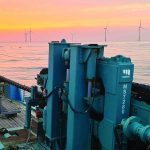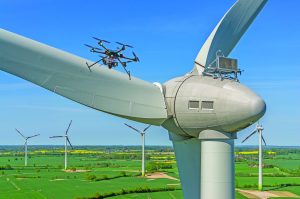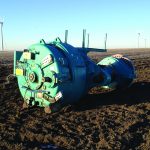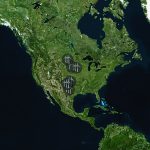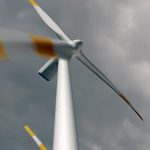After a year of lackluster onshore deployments and turbulence in the offshore sector, the U.S. wind industry appears poised to embark on a resurgence in the coming years.
In 2023, the U.S. installed the smallest amount of new wind capacity in nearly a decade, data collected by the American Clean Power Association (ACP) shows. Developers commissioned just 6.4 GW of wind projects, all land-based, while offshore wind projects previously expected to come fully online in 2023 were delayed. The pace of partial repowering projects also slowed with just 635 MW recorded, about a third of the volume observed during the previous two years.
Supply chain issues, long interconnection queues, permitting delays, and elevated costs for both capital and labor all continued to hold back wind-project development, contributing to the slowdown. Globally, turbine prices remained above pre-pandemic levels in 2023, although well below the price peaks of 2021.
The offshore wind sector also experienced some significant setbacks in 2023, as rising costs made some long-term contracts uneconomical, resulting in five proposed projects being rebid or canceled. When it came to leasing, enthusiasm for the first Gulf of Mexico auction appeared tepid, with just two bidders and one parcel leased.
The Bureau of Ocean Energy Management recently announced a second Gulf offshore wind lease for later this year that will be closely watched. Industry watchers also voiced concerns about realistic timelines for floating offshore wind off the West Coast, sounding the alarm for the prospect of meeting overall deployment targets.

Signs of Future Growth
As the U.S. wind industry leaves the grim statistics of 2023 in the rearview mirror, signs of improvement are everywhere, even as it looks like it will take a little longer for this recovery to fully materialize.
The most concrete sign comes from project spending by developers. New turbine orders increased 130 percent in 2023 from 2022 levels, according to a joint report published by Wood Mackenzie and ACP in early April. The report also found that the bulk of these new orders have delivery dates in 2025 or later, suggesting that 2024 itself may not dazzle.
Energy analyst forecasts show a similar timeline, with an average of three major forecasts showing 7.5 GW of new onshore wind capacity in 2024 and between 9 and 15 GW of additions in 2025. The pace of deployments is predicted to remain consistently strong through the end of the decade, with an average forecast of 16 GW installed in 2030.
More policy certainty around tax credit guidance could also support the outlook for more wind deployments, with the U.S. Department of Treasury issuing clearer rules around how to qualify in the last few weeks of 2023. The Treasury Department is also set to clarify what it takes for projects to meet domestic content requirements and receive a bonus credit, a potentially welcomed outcome given the strong domestic manufacturing base of the U.S. wind industry.
Policy Good News
The Inflation Reduction Act has been an impetus for expanded domestic manufacturing of wind parts, with 12 new or expanded land-based wind power manufacturing facilities and nine offshore wind facilities announced across the country since August 2022. These new manufacturing hubs will provide millions of dollars of investment into local communities and thousands of jobs.
On the offshore wind front, the first commercial-scale offshore wind project was brought online in the first quarter of 2024, with the commissioning of a second large project hot on its heels. The sector is expected to see the 10th Record of Decision issued in July, marking a new milestone for project developments.
Offshore wind leasing could pick up as well, with the Bureau of Ocean Energy Management announcing in December 2023 a sale notice for two lease areas in the Central Atlantic totaling roughly 278,000 acres, with a lease auction expected in 2024. The federal agency also announced plans to work with Maryland to identify additional areas for a second Central Atlantic lease sale in 2025.

Obstacles Remain
Even with a sunnier outlook for future wind deployments, obstacles remain to fully realizing the industry’s potential.
Transmission remains the biggest challenge, as windy areas face congested powerlines to bring electricity to high-population zones, dimming the prospects for building new projects in those same areas and driving new projects to less wind-rich areas.
The U.S. brought just 255 miles of new high-voltage lines online in 2023, barely a sliver of the 10,000 miles developers are trying to deliver by 2030.
Meanwhile, at least 22 high-voltage transmission projects sit in the development stage, ready to clear the way for more wind deployments; however, both local support and political will at all levels of government will be required for them all to become reality.
Reducing the time projects spend in interconnection queues will also be essential to a future wind build-out. Currently, wind projects languish in interconnection queues, on average, for nearly five years, hoping to connect to the grid without undue cost.
This story is not unique to wind as it plagues solar and battery storage projects as well, but wind does tend to take longer to progress through queues owing to its geography and the relatively large size of projects.
Opportunities on Horizon
Despite these challenges, economics, demand, and policy are aligning to provide significant opportunities for wind going forward. Power is needed all day long, and wind is a perfect complement to diurnal solar power and the balancing force of energy-storage plants.
Along the East Coast, there are no real at-scale alternatives to offshore wind to deliver on the regions’ decarbonization goals while meeting demand growth and grid reliability requirements. So, while the past year will be one to forget for the industry, the future is looking breezy.

















